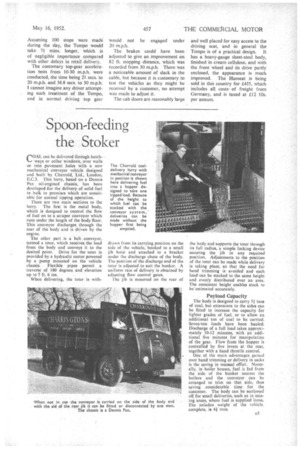Spoon-feeding the Stoker
Page 39

If you've noticed an error in this article please click here to report it so we can fix it.
rOAL can be delivered through hatch ways or cellar windows, over walls or into pavement holes with a new mechanical conveyer vehicle designed and built by Charrold, Ltd., London, E.C.3. This lorry, based on a Dennis Pax oil-engined chassis, has been developed for the.delivery of solid fuel in bulk to premises which are unsuitable for normal tipping operation.
There are two main sections to the lorry. The first is the metal body, which is designed to control the flow of fuel on to a scraper conveyor which runs under the length of the body floor. This conveyor discharges through the rear of the body and is driven by the engine.
The other part is a belt conveyor, termed a toter, which receives the load from the body and conveys it to the desired point. Drive for the toter is provided by a hydraulic motor powered by a pump mounted on the vehicle chassis. Flexible pipes permit a traverse of 180 degrees and elevation up to 7 ft. 6 ins.
When delivering, the toter is with
drawn from its carrying position on the side of the vehicle, hooked to a small jib hoist and attached to a bracket under the discharge chute of the body. The position of the discharge end of the toter is adjusted to suit the bunker. A uniform rate of delivery is obtained by adjusting flow control gates.
The jib is mounted on the rear of the body and supports the toter through its full radius, a simple locking device securing the jib in any required position. Adjustments to the position of the toter can be made while delivery is taking place, so that the need for hand trimming is avoided and each load can be stacked to the same height and evenly distributed over an area. The consistent height • enables stock to be' estimated accurately.
Payload Capacity
The body is designed to carry 51 tons of coal, but extensions to the sides can be fitted to increase the capacity for lighter grades of fuel, or to allow an additional ton of coal to be carried. Seven-ton loads have been hauled. Discharge of a full load takes approximately 10-12 minutes, with an additional five minutes for manipulation of the gear. Flow from the hopper is controlled by five levers at the rear, together with a hand throttle control.
One of the main advantages gained over hand trimming or delivery in sacks is the saving in manual effbrt. Normally, in boiler houses, fuel is fed from the side of the bunker nearest the boilers and the conveyor can be arranged to trim on that side, thus saving considerable time for the customer. The body can be sectioned off for small deliveries, such as in mining areas, where fuel is supplied loose. The unladen weight of the vehicle, complete, is 41 tons.




















































































